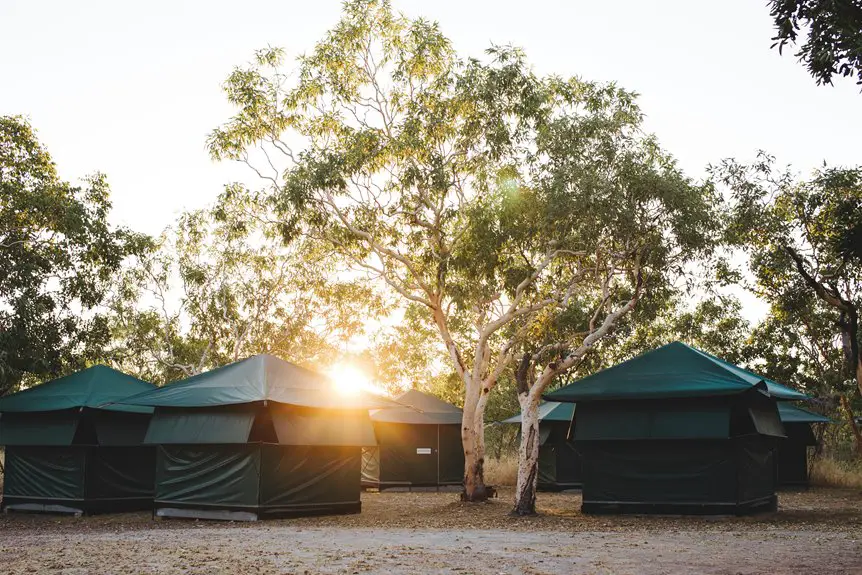To waterproof your polycotton tent for all-weather camping, start by cleaning and thoroughly drying it in a shaded, ventilated area. Choose an eco-friendly waterproofing spray, like silicone or natural wax, that maintains breathability. Don’t forget to repair and apply seam sealant to stitching and weak spots before drying and curing the treatment fully. Regular maintenance and proper storage help preserve waterproofing over time. Keep going, and you’ll discover ways to adapt your tent’s protection for any weather condition.
Table of Contents
Key Takeaways
- Clean and dry the polycotton tent thoroughly before waterproofing to ensure effective product adhesion and sealant performance.
- Use eco-friendly waterproofing products like silicone or natural waxes that maintain breathability and protect against water ingress.
- Apply seam sealant evenly along tent seams and repair any tears to reinforce the weakest water entry points.
- Dry and cure the tent in a shaded, ventilated area for 24-48 hours before packing to maximize waterproofing durability.
- Store the tent dry in a breathable sack, and reapply waterproofing treatments regularly, especially before rainy or humid seasons.
Understanding Polycotton Fabric Properties
Polycotton fabric combines the strength of polyester with the breathability of cotton, giving your tent a unique balance of durability and comfort.
You’ll find that polycotton’s natural fibers allow air to circulate, reducing condensation inside your tent. At the same time, the polyester content enhances its resistance to tears and abrasions, making it sturdy for outdoor use.
You’ll also notice it’s heavier than pure polyester tents but offers better temperature regulation, keeping you cooler in summer and warmer in cooler weather.
Unlike synthetic fabrics, polycotton has a soft, natural feel that’s quieter in the wind.
Understanding these properties helps you appreciate why polycotton tents require specific care and treatment to maintain their performance and longevity during your camping adventures.
Why Waterproofing Polycotton Is Essential
Although the fabric blends natural and synthetic fibers, it won’t keep you dry without proper waterproofing. Polycotton’s breathability is fantastic for condensation control, but it also means water can seep through if untreated.
By waterproofing your tent, you guarantee that rain won’t penetrate the fabric, keeping you comfortable and dry during your camping trips. Without this protection, the tent can absorb moisture, making it heavier and prone to mildew.
Waterproofing also preserves the tent’s structural integrity, preventing fabric degradation from prolonged exposure to water. When you invest time in waterproofing, you extend your tent’s lifespan and enhance its performance in all weather conditions.
Waterproofing protects your tent’s fabric, extending its life and ensuring top performance in any weather.
Simply put, waterproofing polycotton is essential if you want reliable shelter and a pleasant camping experience.
Choosing the Right Waterproofing Products
You’ll want to pick the right waterproofing product to keep your polycotton tent protected without harming the environment.
Consider different types of coatings and eco-friendly options that suit your needs.
Also, knowing the best application methods can make a big difference in how well the waterproofing holds up.
Types of Waterproof Coatings
Finding the right waterproof coating can make all the difference in protecting your tent from rain and moisture. You’ll mostly encounter silicone, polyurethane (PU), and wax-based coatings.
Silicone coatings offer excellent water resistance and flexibility, keeping your tent durable and lightweight. PU coatings are common and affordable, providing solid waterproofing but can wear out faster under intense sun exposure.
Wax-based options penetrate the fabric, enhancing water resistance and breathability, though they require regular reapplication. When choosing, consider your typical camping conditions and how often you’re willing to maintain your tent.
Avoid coatings that might block breathability completely, as your polycotton tent needs to manage moisture inside. Understanding these types helps you pick a coating that balances protection, durability, and comfort for your outdoor adventures.
Eco-Friendly Waterproof Solutions
Choosing eco-friendly waterproofing products lets you protect your polycotton tent without harming the environment.
Look for water-based sprays or solutions that avoid harmful chemicals like perfluorocarbons (PFCs), which persist in nature and can be toxic. Natural waxes, such as beeswax or soy-based options, offer effective waterproofing while remaining biodegradable. Silicone-based treatments are another eco-conscious choice but confirm they’re labeled as non-toxic.
Always check product labels for certifications like OEKO-TEX or bluesign, which indicate safer, sustainable manufacturing. By opting for these greener products, you maintain your tent’s durability and breathability without compromising your environmental values.
Application Methods and Tips
Selecting the right waterproofing product sets the foundation for effective application and long-lasting protection. You’ll want to choose a product specifically designed for polycotton fabrics, such as silicone or fluoropolymer-based sprays. These offer excellent water resistance without compromising breathability.
Avoid heavy waxes that can clog the fabric and reduce ventilation. Before applying, clean your tent thoroughly and make sure it’s dry. Use a spray bottle or applicator pad for even coverage, working in small sections.
Don’t forget seams and stitching, as these are vulnerable spots. Apply multiple light coats rather than one heavy layer to prevent saturation and stiffness. Always follow the manufacturer’s instructions and test on a small area first.
Proper application guarantees your tent stays dry and comfortable, no matter the weather.
Preparing Your Tent for Waterproofing
Before you apply any waterproofing treatment, make sure your polycotton tent is clean and completely dry. This step is vital because dirt and moisture can prevent the waterproofing agent from properly bonding with the fabric.
Lay your tent out flat in a shaded, well-ventilated area to avoid sun damage while drying. Inspect the tent thoroughly for any tears, holes, or weak seams, and repair them before proceeding.
Check zippers and ventilation points, ensuring they’re functional and free of debris. Remove any loose dirt or dust with a soft brush or cloth.
Cleaning Your Polycotton Tent Before Treatment
Since dirt and oils can block waterproof coatings from adhering properly, you’ll need to clean your polycotton tent thoroughly before applying any treatment. Start by brushing off loose dirt, then spot-clean any stains with mild soap and lukewarm water. Avoid harsh detergents or bleach as they can damage the fabric. After cleaning, rinse well to remove soap residue and let it air dry completely in a shaded area to prevent UV damage.
| Cleaning Step | What to Do |
|---|---|
| Remove Loose Dirt | Use a soft brush or broom |
| Spot Clean | Mild soap + lukewarm water |
| Rinse & Dry | Thorough rinse + shade drying |
Proper cleaning helps the waterproof coating bond effectively, ensuring lasting protection for your tent.
Applying a Waterproof Spray Correctly
Once your polycotton tent is clean and completely dry, you can move on to applying the waterproof spray.
Choose a well-ventilated area and lay your tent flat or hang it to access all surfaces easily. Shake the spray can thoroughly before use.
Select a ventilated spot and position your tent flat or hanging for easy, full coverage before spraying.
Hold it about 6 to 8 inches away from the fabric and spray evenly, focusing on seams and high-wear areas. Avoid oversaturating to prevent stiffness.
Apply light, multiple coats rather than one heavy layer, allowing each coat to dry fully before the next. Be sure to cover both the interior and exterior for thorough protection.
Finally, let your tent cure for 24 hours before packing it away or exposing it to rain to guarantee maximum waterproofing effectiveness.
Using Silicone-Based Waterproofing Solutions
Although waterproof sprays are effective, using silicone-based waterproofing solutions can provide a longer-lasting and more flexible barrier for your polycotton tent.
Silicone penetrates the fabric fibers, creating a durable coating that repels water while maintaining breathability. Before applying, make sure your tent is clean and dry.
Use a spray or brush to evenly coat the fabric, focusing on areas prone to heavy rain exposure. Avoid over-saturating to prevent sticky residue.
Let the solution cure fully, usually 24 to 48 hours, for peak performance. Silicone treatments also resist UV damage, extending your tent’s lifespan.
Enhancing Seams With Seam Sealant
When you want to keep water from sneaking through your polycotton tent’s seams, applying seam sealant is essential.
Seams are the weakest points where water can easily penetrate, so sealing them properly enhances your tent’s waterproofing.
Here’s how to tackle it:
- Clean the seams thoroughly to remove dirt and old sealant.
- Use a brush or applicator to spread the seam sealant evenly along the stitching.
- Allow the sealant to dry completely before packing your tent away.
Drying and Curing Your Tent After Waterproofing
After applying waterproofing treatments and seam sealant, you’ll need to let your polycotton tent dry thoroughly to confirm the coatings bond properly.
Set up your tent in a well-ventilated, shaded area away from direct sunlight, which can degrade the waterproofing agents. Avoid packing or folding the tent while it’s still damp, as this can trap moisture and reduce effectiveness.
Depending on humidity and temperature, drying can take anywhere from 12 to 24 hours. Once dry, allow the tent to cure for an additional 24 hours to verify the waterproofing fully adheres to the fabric.
This curing period maximizes durability and water resistance, so be patient. Proper drying and curing are key steps to keep your polycotton tent ready for all-weather adventures.
Regular Maintenance to Preserve Waterproofing
To keep your polycotton tent’s waterproofing effective, you’ll want to perform regular maintenance that addresses wear and environmental exposure. This helps prevent water seepage and extends your tent’s lifespan.
Regular upkeep involves inspecting your tent for any damage, cleaning it properly, and reapplying waterproof treatments as needed.
Here are key maintenance tips to follow:
- Inspect seams and fabric for cracks, holes, or weakened areas after every trip.
- Clean your tent gently using mild soap and water; avoid harsh detergents that can strip waterproof coatings.
- Reapply waterproofing spray or wax annually, or whenever you notice water isn’t beading off like before.
Storing Your Tent to Prevent Damage
Properly storing your polycotton tent prevents damage that can compromise its waterproofing and durability.
Before packing it away, make certain the tent is completely dry to avoid mold and mildew, which weaken the fabric and coatings.
Ensuring your tent is fully dry before storage prevents mold and preserves fabric strength.
Fold it loosely rather than tightly to maintain the fibers’ integrity.
Store your tent in a cool, dry place away from direct sunlight and extreme temperatures, as heat and UV rays degrade waterproof treatments.
Avoid placing heavy objects on top of the tent bag to prevent crushing the fabric and causing permanent creases.
Use a breathable storage sack instead of a plastic bag to allow airflow.
Taking these steps guarantees your polycotton tent stays in prime condition, ready for reliable waterproof performance on your next camping trip.
Tips for Waterproofing in Different Weather Conditions
When the rainy season hits, you’ll want to reinforce your tent’s waterproofing with extra sealant and check all seams carefully.
In humid climates, make sure your tent dries thoroughly to prevent mold and mildew buildup.
Adapting your waterproofing routine to the weather keeps your polycotton tent in top shape.
Rainy Season Preparations
Although polycotton tents offer some natural resistance, you’ll want to take extra steps before the rainy season hits to guarantee your tent stays dry.
Start by thoroughly cleaning your tent to remove dirt and oils that can prevent waterproof coatings from adhering properly. Next, apply a high-quality waterproofing spray designed for polycotton fabrics, focusing on seams and stress points where leaks commonly occur.
Finally, reinforce your tent’s rainfly to create an extra barrier against heavy downpours.
- Clean the tent fabric and seams before treatment
- Use a waterproof spray made for polycotton materials
- Check and reinforce the rainfly for added protection
Humid Climate Strategies
Since humid climates can cause moisture to linger longer on your polycotton tent, you’ll need to take extra care to prevent mold and mildew while maintaining waterproofing. Focus on thorough drying after rain, use breathable waterproof sprays, and store your tent in a dry place. Ventilation is key to reduce condensation inside the tent.
| Strategy | Purpose | Tips |
|---|---|---|
| Thorough Drying | Prevent mold/mildew | Dry tent fully before packing |
| Breathable Sprays | Maintain waterproofing | Use silicone-based, flexible sprays |
| Ventilation | Reduce condensation | Keep vents open or use mesh panels |
| Proper Storage | Avoid dampness buildup | Store in a cool, dry, ventilated area |
These steps help you keep your tent dry and durable in humid conditions.
Frequently Asked Questions
Can Polycotton Tents Be Safely Washed in a Washing Machine?
You shouldn’t wash polycotton tents in a washing machine because it can damage the fabric and waterproof coating. Instead, gently clean them by hand with mild soap and cold water to keep them safe and durable.
How Long Does Waterproofing Treatment Typically Last on Polycotton Tents?
You’ll find waterproofing treatments on polycotton tents usually last about one to two camping seasons. However, you’ll want to reapply after heavy use or intense weather to keep your tent reliably water-resistant and protected.
Are There Any Environmental Concerns With Waterproofing Products?
Imagine a lake polluted by runoff from harmful waterproofing chemicals. You’ll want to avoid products with PFAS, which persist in the environment and harm wildlife. Choose eco-friendly, biodegradable treatments to protect nature and your gear.
Can Waterproofing Affect the Breathability of Polycotton Fabric?
Yes, waterproofing can reduce polycotton fabric’s breathability because coatings block moisture escape. You’ll want to choose breathable waterproof treatments or apply them sparingly to keep your tent comfortable without trapping condensation inside.
Is Professional Waterproofing Service Recommended Over DIY Methods?
You don’t have to choose professional services unless you want guaranteed results or lack time. DIY methods work well if you follow instructions carefully, but pros guarantee even application and long-lasting waterproofing without risking damage.
- Does Chiffon Fabric Stink - July 15, 2025
- Does Chiffon Fabric Affect the Economy - July 15, 2025
- Does Cotton Fabric Have a Nap - July 15, 2025







